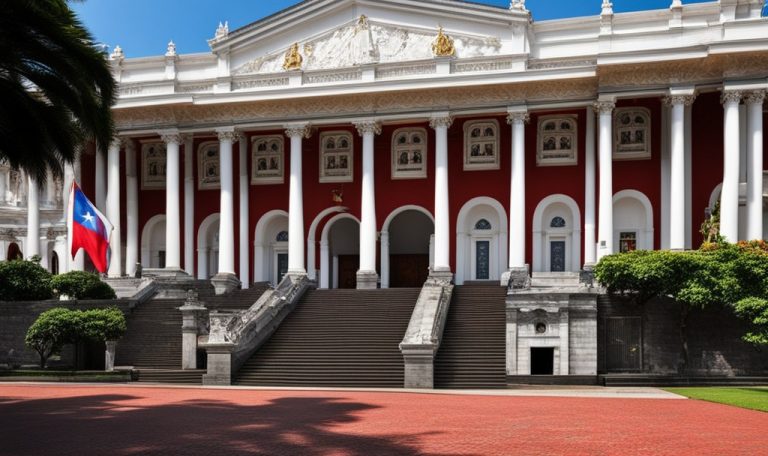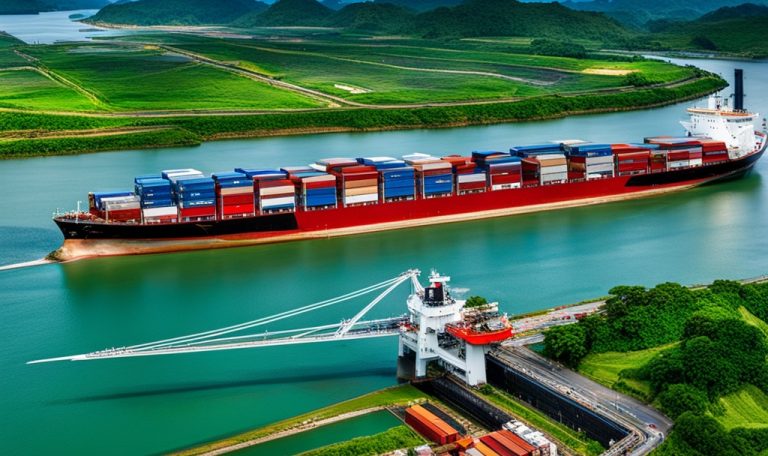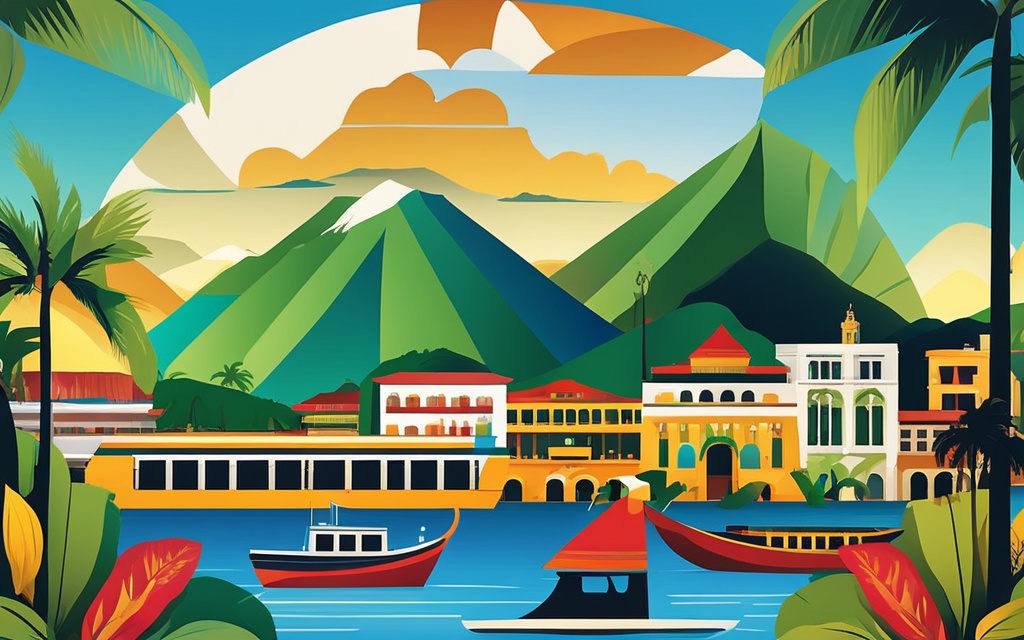Panama sits at the heart of North and South America, linking the Atlantic and Pacific Oceans. This spot made it crucial to the US, leading to its support for Panama’s independence in 1903. The US helped Panama become its own country to build the famous Panama Canal.
This canal, connecting the Atlantic and Pacific Oceans, has been key to Panama’s wealth. It’s not just about the canal, though. Panama boasts the largest rainforest in the Western Hemisphere outside the Amazon Basin. This shows the country’s rich variety of landscapes.
Its history is deep, with roots in indigenous cultures and Spanish rule. Today, Panama thrives with a strong economy and lively culture. It’s a place full of stories for those who visit or study it.
Key Takeaways
- Panama’s strategic location at the crossroads of North and South America, and the Atlantic and Pacific Oceans, has made it a subject of significant US interest.
- The Panama Canal is an engineering marvel that has played a crucial role in the country’s economy, connecting the Atlantic and Pacific Oceans.
- Panama is home to the largest rainforest in the Western Hemisphere outside the Amazon Basin, showcasing the nation’s diverse and captivating landscapes.
- The country’s history is rooted in indigenous civilizations and Spanish colonization, shaping its rich cultural heritage.
- Panama’s thriving modern economy and vibrant cultural traditions offer a compelling and multifaceted country profile for visitors and researchers.
Introduction to Panama
Panama is a country between North and South America. It has a key location that has shaped its history and growth. At the crossroads of the Atlantic and Pacific Oceans, Panama is famous for its panama geography and the panama canal. This canal is a huge engineering feat that boosts its economy and global importance.
Strategic Geographical Location
Panama sits at the narrow isthmus between North and South America. Its panama strategic location has made it a key spot for trade and commerce. It connects the world’s major waterways, making it crucial for global trade.
This location has shaped Panama’s history. Many colonial powers wanted it for its strategic spot. It has made Panama culturally diverse, influential, and prosperous.
The Panama Canal: An Engineering Marvel
The panama canal is Panama’s greatest geographical achievement. Finished in 1914, it changed global trade by linking the Atlantic and Pacific Oceans directly. It turned Panama into a key center for international trade and logistics.
Building the canal was a huge engineering challenge. It faced tropical diseases and tough geography. Now, it’s a key route for moving goods across the globe, making Panama a strategic world player.
“The Panama Canal is one of the most significant achievements of the 20th century, connecting the world’s two largest oceans and revolutionizing global trade.”
Panama’s Rich History
Panama’s history is full of stories from indigenous peoples, Spanish rule, and the fight for independence. The first people, like the Chibchan, Chocoan, and Cueva, lived in the region for centuries. Then, the Spanish arrived in the 1500s, changing everything.
The Spanish brought diseases that killed many of the native people. They also built cities, like Panama City, and brought Catholicism. This time also saw the start of a trade route that linked the Atlantic and Pacific Oceans.
Indigenous Civilizations and Spanish Colonization
Before the Spanish came, Panama was home to thriving communities. The Chibchan, Chocoan, and Cueva peoples had their own ways of farming, living, and making art. But the Spanish brought diseases that killed many of them.
After the Spanish came, they built cities and brought Catholicism. They also started a trade route that was key for the Spanish Empire.
From Independence to the Present Day
- In 1821, Panama became its own country, starting a new chapter.
- The 1800s were hard times, with political issues and a failed Scottish colony plan. Panama joined the Republic of Gran Colombia.
- The Panama Canal’s building in the early 1900s changed the country’s role in the world.
- In 1989, the US invaded Panama to remove Manuel Noriega, a big event in its history.
- Now, Panama is a modern, democratic country. It’s important in world affairs because of its location and the Panama Canal.
“Panama’s history is a tapestry of resilience, cultural exchange, and global significance.“
Panama Country Profile
Panama is a country in Central America, known for its rich culture and strategic location. It has a population of about 4.3 million people. The country has diverse landscapes, from lush rainforests to beautiful coasts and the famous Panama Canal.
Panama City, the capital, is a mix of modern and historic buildings. Spanish is the official language, but English is also common, especially in business and tourism.
Panama’s Diverse Demographics
Panama’s people come from many cultures. Indigenous groups like the Ngäbe and the Kuna live alongside people of Spanish, African, and European descent. This mix shows in the country’s traditions, customs, and food.
| Ethnic Composition | Percentage |
|---|---|
| Mestizo (mixed European and indigenous) | 65% |
| Indigenous | 12.3% |
| Afro-Panamanian | 9.2% |
| White | 6.8% |
| Asian | 6.7% |
This mix of people makes Panama’s culture lively and interesting. It’s a great place to visit for people from all over the world.
Geography and Climate
Panama is the southernmost country in Central America. It has a diverse and captivating landscape. This shows off the region’s remarkable panama geography and panama ecosystems. From lush rainforests to stunning panama climate along its coasts, it’s full of natural wonders.
Diverse Landscapes and Ecosystems
Panama’s tropical climate and varied terrain make its natural environment unique and full of life. It has the largest rainforest in the Western Hemisphere outside the Amazon Basin. This place is a haven for many plant and animal species.
The country’s ecosystems vary from cloud forests in the highlands to mangrove-lined shores. Each place is full of life.
- Lush, verdant rainforests that cover nearly 40% of the country
- Stunning volcanic peaks and rugged mountain ranges
- Pristine beaches and vibrant coral reefs along the Pacific and Caribbean coasts
- Serene lakes, rivers, and wetlands that support a thriving aquatic ecosystem
Panama’s panama geography and panama landscapes make it a paradise for nature lovers. It offers endless chances for outdoor adventures and seeing wildlife. Whether you’re hiking, snorkeling, or just enjoying the views, it will leave a lasting impression.
“Panama’s natural beauty is truly a sight to behold, from the towering mountain peaks to the lush, biodiverse rainforests.” – Jane Doe, National Geographic Explorer
Economy and Trade
Panama’s economy is closely linked to the famous Panama Canal. This canal greatly adds to the country’s GDP. Panama has also grown its main industries. These include banking, finance, logistics, and tourism.
The Panama Canal’s Contributions
The Panama Canal is a key trade route worldwide. It has been crucial for Panama’s economic growth. It connects the Pacific and Atlantic Oceans, moving goods and services. This helps bring in a lot of money for Panama’s economy.
This money lets the government invest in things like infrastructure and social programs. It also supports sustainable development projects.
Key Industries and Sectors
- Banking and Finance: Panama is now a big financial center. It draws in banks and financial groups with its good tax laws and strong legal setup.
- Logistics: Panama uses its great location to be a key place for logistics and distribution. It has top-notch ports and a growing logistics sector.
- Tourism: Panama’s varied landscapes, rich culture, and modern facilities make it a popular spot for tourists. This boosts the country’s economy a lot.
With President José Raúl Mulino leading, Panama keeps drawing in investors and growing its economy. It aims to be a big player in trade, finance, and tourism in the region.
“The Panama Canal is a vital artery for global trade, and its importance to Panama’s economy cannot be overstated.”
Government and Politics
Panama has a vibrant democratic government, with the president as both head of state and government. The country has seen ups and downs, like the U.S. invasion in 1989 to remove Manuel Noriega. Now, Panama has made big changes, including getting rid of its army.
The current president, José Raúl Mulino, is working on big issues like crime and clean water. Panama’s politics have changed for the better, making its democracy more stable and clear.
Panama’s Transition to Democracy
After years under military rule, Panama has grown its democracy. It has made big changes, like:
- Abolishing the army
- Putting more limits on the president’s power
- Working to stop corruption and make government more open
| Key Facts about Panama’s Government | Details |
|---|---|
| Political System | Democratic republic with a president as the head of state and government |
| Current President | José Raúl Mulino |
| Key Political Parties | Democratic Revolutionary Party (PRD), Panameñista Party (PP), Democratic Change (CD) |
| Recent Reforms | Abolition of the standing army, increased checks on presidential power, anti-corruption measures |
The US invasion of Panama in 1989 was a big moment. It led to a move towards a more stable and democratic government and politics.

Culture and Traditions
Panama’s culture is a mix of indigenous, Spanish, and international influences. The Chibchan, Chocoan, and Cueva peoples have greatly influenced Panama’s culture. This is seen in the art, music, and traditions across the nation.
Indigenous Influences
The indigenous cultures of Panama have deeply shaped the country’s art and traditions. The Guna people’s basket weaving and the Ngäbere tribe’s drums show the indigenous impact. This influence is clear in Panama’s cultural scene.
Festivals and Celebrations
Panama is known for its lively festivals and celebrations. These events often include traditional dances, music, and local food. The Carnival of Panama is a big event that honors the country’s culture and traditions.
Other festivals like the panama indigenous San Sebastián festival and the panama festivals of La Mejorana and La Pollera highlight the unique culture of the Panamanian people.
“Panama’s culture is a tapestry of diverse influences, woven together to create a truly unique and captivating experience.”
| Festival | Description | Location |
|---|---|---|
| Carnival of Panama | Lively celebration with traditional dances, music, and cuisine | Throughout Panama |
| San Sebastián Festival | Celebration of the panama indigenous culture and traditions | Guna Yala region |
| La Mejorana Festival | Festival showcasing panama traditions and panama culture | Monagrillo, Herrera Province |
| La Pollera Festival | Celebration of the traditional Panamanian dress and panama culture | Las Tablas, Los Santos Province |
Tourism and Attractions
Panama is a captivating place in Central America. It has something for every traveler. From natural wonders to historical sites and urban explorations, there’s a lot to see and do.
Natural Wonders and Outdoor Adventures
Panama’s nature is breathtaking. You’ll find lush rainforests, beautiful beaches, and a lot of wildlife. If you love the outdoors, you can go hiking in Soberania National Park, bird watching in the Pipeline Road, or snorkeling in the San Blas Islands.
Historical Sites and Urban Exploration
Panama’s history is fascinating. You can see it at its historical sites. Visit the old city of Panama, the Panama Canal, and cultural museums. The city also has a mix of new skyscrapers and old landmarks for those who like to explore the city.
| Top Panama Attractions | Description |
|---|---|
| Panama Canal | An engineering marvel connecting the Atlantic and Pacific Oceans |
| Casco Viejo | The historic colonial quarter of Panama City, a UNESCO World Heritage Site |
| San Blas Islands | An archipelago of 365 islands, home to the indigenous Guna Yala people |
| Bocas del Toro | A vibrant coastal region known for its beaches, water sports, and ecotourism |

“Panama is a country that’s rich in history, culture, and natural beauty. It’s a place where you can explore the wonders of the world-famous Panama Canal, hike through lush rainforests, and discover the unique charm of its colonial cities.”
Conclusion
Panama is a place full of culture, history, and natural beauty. It’s famous for the Panama Canal, a huge achievement in engineering that changed global trade. The country also has diverse ecosystems and a strong indigenous culture, offering lots to see and learn.
Panama is a key spot for world trade and a popular place for tourists. It combines modern life with traditional ways, giving visitors a unique and memorable trip. Whether you’re interested in the panama country profile, the stunning nature, or the deep culture, Panama will surely impress you.
Starting your trip in this amazing country means getting ready for adventure and discovery. You’ll find incredible sights, sounds, and experiences. Let Panama’s beauty and culture touch your heart and inspire you.



